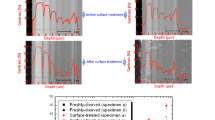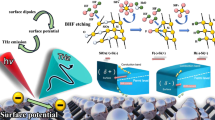Abstract
This paper discusses the development of a high-accuracy endpointing algorithm for the emitter etch of a heterojunction bipolar transistor (HBT). Fabrication of high-performance HBTs using self-aligned base-emitter processes requires etching through the emitter layer and stopping with very high accuracy on the base layer. The lack of selectivity in dry etching coupled with the high etch rates possible in high density plasmas render the use of a standard timed overetch impractical, especially as device layers continue to become thinner. The etch process under study requires the complete removal of an AlInAs emitter while etching no more than 5 nm of the underlying GaInAs base layer. Etch products are monitored using optical emission spectroscopy (OES) to determine etch endpoint. The process under study relies on the intensity of the 417.2 nm Ga emission line. The detection of the Ga line indicates that the etch has reached the GaInAs layer. However, the presence of a time-varying Ga baseline signal before endpoint and significant noise in the OES signal necessitate more than a simple threshold scheme for critical endpoint detection. The algorithm presented here is based on a generalized likelihood ratio with a signature function. This algorithm is robust to variance in the optical gains of the measurement equipment and is applicable to other etch processes. Experimental results of automated endpointing using this algorithm are presented in the form of pre- and post-etch ex situ film thickness measurements.
Similar content being viewed by others
References
Sonny Maung, Somnath Banerjee, Dennis Draheim, Steven Henck and Stephanie Watts Butler, IEEE Trans. on Semiconductor Manufacturing (1994).
H.C. Sun, V. Patel, B. Singh, C.K. Ng and E.A. Whittaker, Appl. Phys. Lett. (1994).
Ronald L. Allen, Randy Moore and Mike Whelan, J. Vac. Science and Techn. B 14 (1): 498, January/February (1996).
Herbert E. Litvak, J. Vac. Science and Techn. B (1996).
S.W. Pang, K.T. Sung and K.K. Ko, J. Vac. Science and Techn. B (1992).
L. Ljung, System Identification: Theory for the User, (Prentice-Hall, 1987).
Michèle Basseville and Igor V. Nikiforov, Detection of Abrupt Changes, (Prentice Hall, Inc., 1993).
S. Thomas III, H.H. Chen and S.W. Pang, Materials Research Society Symp. Proc., 406, (Pittsburgh, PA: Materials Research Society, 1996), p. 27.
Leonard I. Kamlet, Ph.D. thesis, University of Michigan, 1995.
Author information
Authors and Affiliations
Rights and permissions
About this article
Cite this article
Hanish, C.K., Grizzle, J.W., Chen, H.H. et al. Modeling and algorithm development for automated optical endpointing of an HBT emitter etch. J. Electron. Mater. 26, 1401–1408 (1997). https://doi.org/10.1007/s11664-997-0058-z
Received:
Accepted:
Issue Date:
DOI: https://doi.org/10.1007/s11664-997-0058-z




